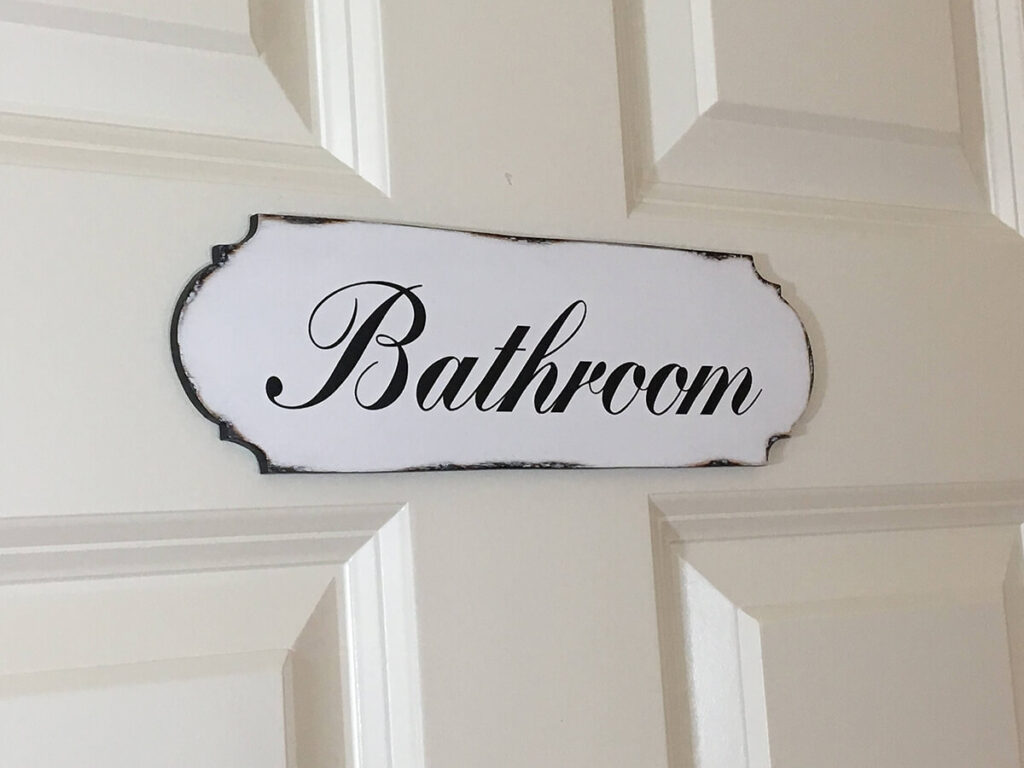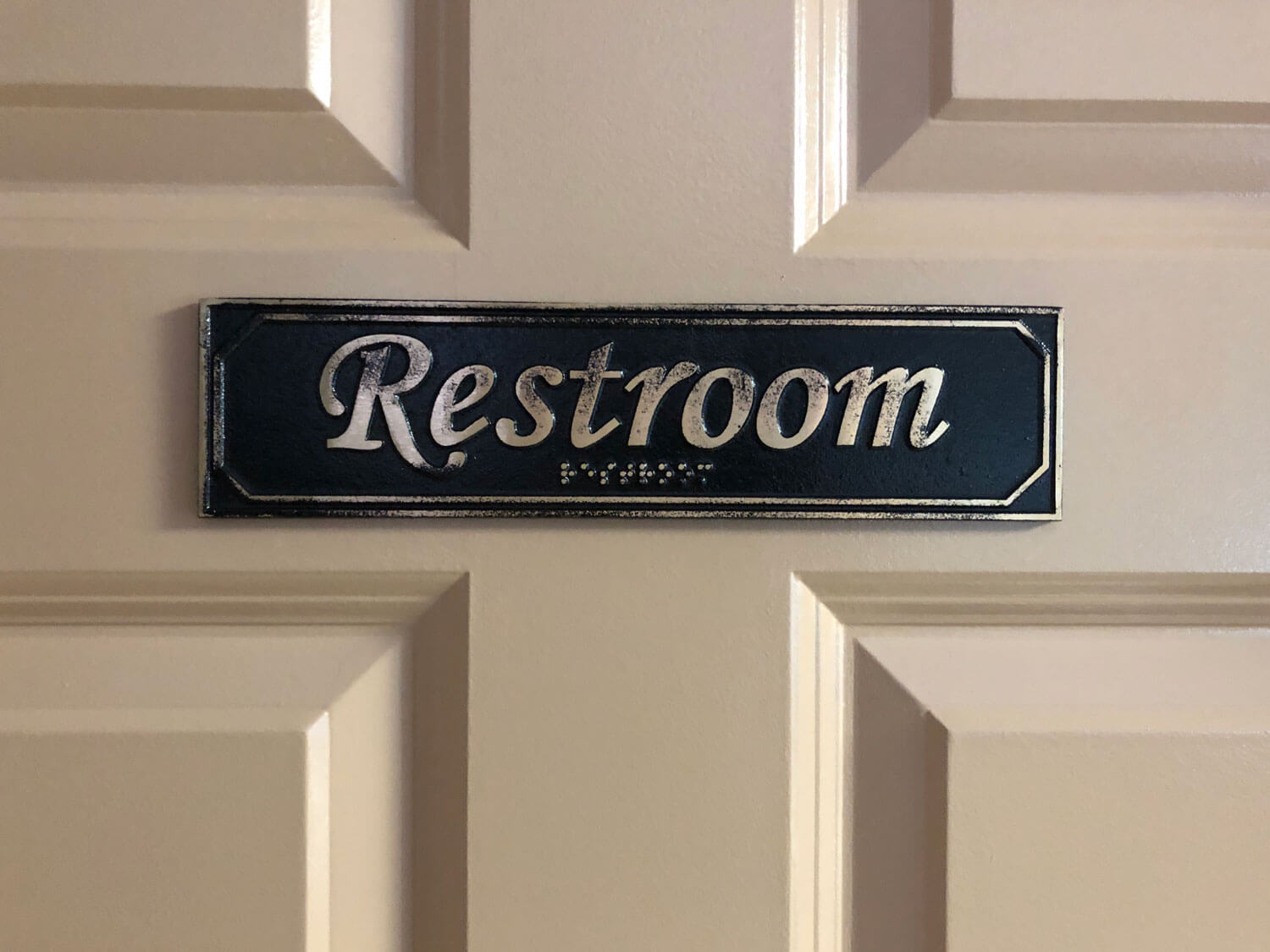Types of Bathroom Door Signs

Bathroom door signs are an essential part of any home, serving both practical and decorative purposes. They clearly indicate the room’s function and can add a touch of personality to your space. Let’s explore the different aspects of bathroom door signs, from materials and designs to text formats and common types.
Materials Used for Bathroom Door Signs
The material of your bathroom door sign significantly impacts its durability, style, and overall cost.
- Wood: Wood is a classic and versatile material for bathroom door signs. It offers a natural aesthetic and can be stained or painted to match your decor. Wooden signs are generally durable and can be customized with intricate designs. However, wood can be susceptible to moisture damage, especially in humid environments.
- Metal: Metal signs, such as those made of aluminum or stainless steel, are highly durable and resistant to moisture. They can be polished for a sleek, modern look or left with a rustic finish. Metal signs are also relatively easy to clean and maintain. However, metal can be more expensive than other materials and may require special hardware for installation.
- Acrylic: Acrylic signs offer a contemporary look and are lightweight and easy to handle. They come in a variety of colors and can be customized with various designs and text formats. Acrylic is also resistant to moisture and scratches, making it a practical choice for bathroom door signs. However, acrylic can be more prone to chipping or cracking if not handled carefully.
Design Styles for Bathroom Door Signs
The design style of your bathroom door sign should complement the overall aesthetic of your bathroom.
- Modern: Modern bathroom door signs often feature clean lines, minimalist designs, and bold typography. They may use materials like metal, acrylic, or even printed vinyl for a contemporary look. For example, a simple black and white sign with a geometric pattern and the word “Bathroom” in a sans-serif font could be considered modern.
- Rustic: Rustic bathroom door signs often feature natural materials like wood or reclaimed metal. They may have a distressed or weathered finish, and the typography can be more traditional or whimsical. For instance, a wooden sign with the words “Restroom” carved in a rustic font and adorned with a simple floral design could be classified as rustic.
- Minimalist: Minimalist bathroom door signs prioritize simplicity and functionality. They typically feature a single word or icon in a clean, modern font. The use of neutral colors and minimal embellishments further enhances the minimalist aesthetic. For example, a white acrylic sign with a black silhouette of a toilet and the word “WC” in a sans-serif font could be considered minimalist.
Text Formats for Bathroom Door Signs
The text format of your bathroom door sign can be playful, informative, or even humorous.
- Funny: Funny bathroom door signs use witty wordplay, puns, or humorous illustrations to add a touch of laughter to your space. Examples include signs that say “Caution: May contain laughter” or “Warning: May cause spontaneous urination.” These signs are perfect for adding a lighthearted touch to your bathroom.
- Whimsical: Whimsical bathroom door signs often feature whimsical illustrations, decorative fonts, or playful text. They can add a touch of charm and personality to your bathroom. Examples include signs with cartoon animals, floral patterns, or whimsical fonts that say “Powder Room” or “Washroom.” These signs can be a fun way to personalize your bathroom.
- Classic: Classic bathroom door signs use simple, traditional text and fonts. They are often made of wood or metal and may feature a simple design. Examples include signs that say “Bathroom” or “Restroom” in a classic serif font. These signs are a timeless choice for any bathroom and can be easily incorporated into any decor style.
Common Types of Bathroom Door Signs
Bathroom door signs serve various purposes, from indicating occupancy to identifying specific rooms.
- Occupied/Vacant: Occupied/vacant signs are essential for multi-user bathrooms, especially in public spaces. These signs are typically placed on the outside of the door and indicate whether the bathroom is in use. They can be simple indicators with words like “Occupied” or “Vacant” or feature icons like a green checkmark for “Vacant” and a red “X” for “Occupied.”
- Gender-Specific: Gender-specific bathroom door signs are used to designate bathrooms for men or women. These signs typically feature symbols like a male or female silhouette or words like “Men’s” or “Women’s.” They are crucial for ensuring privacy and comfort in public and private settings.
- Family-Friendly: Family-friendly bathroom door signs are designed for homes with children. They may feature cute illustrations, fun fonts, or playful text to make the bathroom more appealing to young users. For example, a sign with a cartoon character holding a toothbrush and the words “Kids’ Bathroom” could be considered family-friendly. These signs can help create a positive and welcoming atmosphere for children.
Bathroom Door Sign Functionality

Bathroom door signs serve a crucial purpose in any home, especially in multi-person households. They provide clear and concise information about the room’s function and status, ensuring smooth and efficient use of the bathroom.
Importance of Clear and Concise Wording
The wording on bathroom door signs should be straightforward and easily understood by everyone who might use the bathroom. Avoid using jargon or slang, as it could lead to confusion.
Effective Wording Examples, Bathroom door signs for home
Here are some examples of effective wording for different types of bathroom door signs:
- Single-person bathroom: “Bathroom,” “John’s Bathroom,” “Guest Bathroom”
- Shared bathroom: “Shared Bathroom,” “Family Bathroom,” “Upstairs Bathroom”
- Occupied bathroom: “Occupied,” “In Use,” “Busy”
- Vacant bathroom: “Vacant,” “Available,” “Free”
Visual Cues on Bathroom Door Signs
Visual cues, such as icons or symbols, can enhance the clarity and accessibility of bathroom door signs. They can be especially helpful for young children or people who may have difficulty reading.
Design Choices for a Shared Bathroom in a Multi-family Home
For a shared bathroom in a multi-family home, consider a sign with the following elements:
- Text: “Shared Bathroom” in a clear and legible font.
- Icon: A universal bathroom symbol, such as a silhouette of a toilet and bathtub, for quick recognition.
- Color: A neutral color that blends with the surrounding décor.
- Size: Large enough to be easily visible from a distance.
- Material: Durable and weather-resistant, such as metal or plastic.
Bathroom Door Sign Placement and Installation: Bathroom Door Signs For Home

The placement of a bathroom door sign is crucial for its effectiveness. It should be clearly visible and easily accessible to anyone entering the room. Installation methods also play a significant role in ensuring the sign remains securely attached and aesthetically pleasing.
Placement
The ideal placement for a bathroom door sign is on the door itself, near the handle or knob. This ensures that the sign is visible to anyone approaching the door, regardless of their direction. The sign should be placed at a comfortable height, typically around eye level for most adults. Avoid placing the sign too high or too low, as this can make it difficult to read.
Installation Methods
Several methods can be used to install bathroom door signs, each with its own advantages and disadvantages. The most common methods include:
Adhesive
Adhesive-backed signs are a popular choice for temporary or light-duty applications. They are easy to install and remove, leaving minimal residue. However, they may not be suitable for heavy signs or surfaces with uneven textures.
Screws
For more permanent installations, screws are the preferred method. They offer a secure hold and are suitable for heavier signs. However, they require drilling holes into the door, which may damage the surface. Ensure that the screws are appropriate for the door material and thickness.
Hinges
Hinges can be used to create a more decorative and functional installation. They allow the sign to swing open, revealing additional information or a decorative element. However, hinges can be more complex to install and require careful measurements and alignment.
Step-by-Step Guide: Installing a Bathroom Door Sign with Adhesive
Here’s a step-by-step guide to installing a bathroom door sign using adhesive:
1. Clean the door surface: Use a damp cloth to remove any dirt, dust, or debris from the area where the sign will be placed. Allow the surface to dry completely before proceeding.
2. Position the sign: Hold the sign in place where you want it to be installed. Use a pencil to lightly mark the edges of the sign.
3. Peel the backing: Remove the adhesive backing from the sign, exposing the adhesive strip.
4. Apply the sign: Carefully align the sign with the marked area and press firmly onto the door surface. Ensure that the entire adhesive strip is in contact with the door.
5. Hold the sign: Hold the sign in place for several seconds to allow the adhesive to bond. Avoid touching the sign for at least 24 hours to allow the adhesive to fully cure.
Installation Options
| Method | Pros | Cons | Materials | Tools | Estimated Cost |
|---|---|---|---|---|---|
| Adhesive | Easy to install and remove, minimal residue | Not suitable for heavy signs or uneven surfaces, may not be permanent | Adhesive-backed sign | None | $5-$15 |
| Screws | Secure hold, suitable for heavier signs | Requires drilling holes, may damage the door surface | Screws, drill, screwdriver | $10-$25 | |
| Hinges | Decorative and functional, allows for additional information or a decorative element | More complex to install, requires careful measurements and alignment | Hinges, screws, drill, screwdriver | $20-$50 |